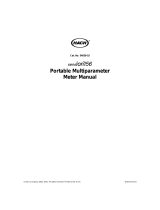3
Table of Contents
Section 1 Specifications ....................................................................................................................... 5
Section 2 General Information.............................................................................................................. 7
2.1 Safety information.............................................................................................................................. 7
2.1.1 Hazard notices in this manual...................................................................................................7
2.1.2 Precautionary labels ................................................................................................................. 7
2.2 Overview of product........................................................................................................................... 8
2.3 Measurement instrument ................................................................................................................... 8
2.4 Measuring principle............................................................................................................................ 8
2.5 Probe ................................................................................................................................................. 8
Section 3 Installation ............................................................................................................................. 9
3.1 Product contents................................................................................................................................ 9
3.2 Powered via rechargeable batteries ................................................................................................ 10
3.2.1 Inserting the rechargeable batteries ....................................................................................... 10
3.2.2 Install the charger ................................................................................................................... 11
3.2.3 Charging the rechargeable batteries....................................................................................... 12
3.3 Connecting the probe ...................................................................................................................... 13
3.4 Switching the instrument on and off................................................................................................. 14
3.4.1 Register a new probe.............................................................................................................. 14
Section 4 Start Up ................................................................................................................................ 15
4.1 System start overview...................................................................................................................... 15
4.2 User interface and navigation .......................................................................................................... 15
4.2.1 Keypad.................................................................................................................................... 15
4.2.2 Display .................................................................................................................................... 16
4.2.2.1 Querying internal information......................................................................................... 17
4.3 Select language ............................................................................................................................... 17
4.4 Setting the date and time................................................................................................................. 17
4.5 Setting the display ........................................................................................................................... 18
4.6 Setting the units ............................................................................................................................... 18
4.6.1 Sludge blanket level................................................................................................................ 18
4.7 Calibration........................................................................................................................................ 19
4.8 Defining the measurement points .................................................................................................... 19
4.8.1 Overview of calibration curves................................................................................................ 19
4.8.2 Measurements ........................................................................................................................ 19
4.8.2.1 Practical example for solids measurement .................................................................... 19
4.8.2.2 Practical example for turbidity measurement................................................................. 21
4.9 Setting the integration time .............................................................................................................. 21





























